Research of Vibrations of an Armoured Personnel Carrier Hull with FE Implementation
Abstract
1. Introduction
2. Methods
2.1. Experimental Study
2.2. Numerical Study
2.3. Hull Configurations
2.4. Methodology of Comparison of Vibration Mode Shapes
3. Results
3.1. Modal Analysis
3.2. Supplementary Experimental Test
4. Summary and Conclusions
- The experimental test results for subsequent stages of construction completion were compared with the model test results and showed a good agreement in regards to both the vibration and frequency mode shapes. For the configurations considered, the relative frequency difference between experimental and model test results in most cases did not exceed 3%, reaching 6.1% in the worst case. For virtually all vibration mode shapes, the MAC index reached values above 0.9. The only exception was the fourth shape in the configuration with a fixed turret, where the MAC index reached the value of 0.86.
- Modal analysis based on a roving hammer showed limitations related to the excitation of a complex structure with significant mass. Due to the insufficient magnitude of the transmitted force pulse as a result of a single impact, the model analysis did not show natural vibrations with a frequency of approximately 13 Hz, a value revealed by the model tests for the variant including a hull with brackets, a bearing, and a turret. This figure was associated with the turret movement and vibrations of its bottom plate.
- Additional tests, including the pulsed load of the turret with a moving mass, showed a vibration frequency of approximately 13 Hz (both in the recorded strain at the three measuring points as well as the force in the brackets). A comparison of the results obtained by experimental and model studies allowed us to conclude that the developed numerical model largely reflects the construction of a real object.
- Satisfactory validation of the model entitles the authors to conduct further research. The developed model will be used to determine the stress state of hull during on-board weapon firing as well as to assess what other weapon systems can be installed on this type of structure. In addition, it is also planned to complement the experimental and numerical studies with theoretical analyses, including the issues of natural vibrations and internal ballistics.
Author Contributions
Funding
Institutional Review Board Statement
Informed Consent Statement
Data Availability Statement
Acknowledgments
Conflicts of Interest
References
- Rusiński, E.; Koziołek, S.; Jamroziak, K. Quality assurance method for the design and manufacturing process of armoured vehicles. Eksploat. Niezawodn. 2009, 43, 70–77. [Google Scholar]
- Hosseinloo, A.H.; Vahdati, N.; Yap, F.F. A Parametric Shock Analysis of Spade-Less, Lightweight, Wheeled, Military Vehi-cles Subjected to Cannon Firing Impact: A Feasibility Study of Spade Removal. Int. J. Acoust. Vib. 2013, 18, 183–191. [Google Scholar]
- Mackiewicz, A.; Sławiński, G.; Niezgoda, T.; Będziński, R. Numerical Analysis of the Risk of Neck Injuries Caused By IED Explosion under the Vehicle in Military Environments. Acta Mech. Autom. 2016, 10, 258–264. [Google Scholar] [CrossRef][Green Version]
- Suhaimi, K.; Risby, M.; Tan, K.; Knight, V.F.; Sohaini, R.M.; Sheng, T.K. Simulation on the Shock Response of Vehicle Occupant Subjected to Underbelly Blast Loading. Procedia Comput. Sci. 2016, 80, 1223–1231. [Google Scholar] [CrossRef]
- Mikulic, D. Design of Demining Machines; Springer: London, UK, 2013. [Google Scholar]
- Park, C.Y. Numerical study on determining design parameters of wheeled armored vehicles. J. Mech. Sci. Technol. 2017, 31, 5785–5799. [Google Scholar] [CrossRef]
- Rybak, P. Shaping the Impact Resistance of the Supporting Structures of Combat Vehicles; WAT: Warsaw, Poland, 2013. (In Polish) [Google Scholar]
- Pyka, D.; Jamroziak, K.; Blazejewski, W.; Bocian, M. Calculations with the Finite Element Method during the Design Ballistic Armour. In Proceedings of the 4th International Conference on Industrial Engineering, Wrocław, Poland, 22–24 June 2017; pp. 451–459. [Google Scholar]
- Sławiński, G.; Malesa, P.; Świerczewski, M. Analysis Regarding the Risk of Injuries of Soldiers inside a Vehicle during Accidents Caused by Improvised Explosive Devices. Appl. Sci. 2019, 9, 4077. [Google Scholar] [CrossRef]
- Dursun, T.; Büyükcivelek, F.; Utlu, Ç. A review on the gun barrel vibrations and control for a main battle tank. Def. Technol. 2017, 13, 353–359. [Google Scholar] [CrossRef]
- Jambovane, S.; Kalsule, D.; Athavale, S. Validation of FE Models Using Experimental Modal Analysis; SAE Technical Paper Series; SAE: Warrendale, PA, USA, 2001. [Google Scholar] [CrossRef]
- Gupta, A. Evaluation of a fully assembled armored vehicle hull–turret model using computational and experimental modal analyses. Comput. Struct. 1999, 72, 177–183. [Google Scholar] [CrossRef]
- Morris, B. Modal Analysis of the Prototype Heavy Composite Hull (HCH) [Research Report]; ARL-MR-387; Army Research Laboratory: Aberdeen, SD, USA, 1998. [Google Scholar]
- Howle, D.; Krayterman, D.; Pritchett, J.E.; Sorenson, R. Validating a Finite Element Model of a Structure Subjected to Mine Blast with Experimental Modal Analysis [Research Report]; ARL-TR-8224; Army Research Laboratory: Aberdeen, SD, USA, 2017. [Google Scholar]
- Hryciów, Z.; Wiśniewski, A.; Rybak, P. Experimental and Numerical Modal Analysis of the Military Vehicle Hull. Adv. Mil. Technol. 2020, 15, 379–391. [Google Scholar] [CrossRef]
- Rezvani, S.S.; Kiasat, M.S. Analytical and experimental investigation on the free vibration of a floating composite sandwich plate having viscoelastic core. Arch. Civ. Mech. Eng. 2018, 18, 1241–1258. [Google Scholar] [CrossRef]
- Rusinski, E.; Dragan, S.; Moczko, P.; Pietrusiak, D. Implementation of experimental method of determining modal characteristics of surface mining machinery in the modernization of the excavating unit. Arch. Civ. Mech. Eng. 2012, 12, 471–476. [Google Scholar] [CrossRef]
- Rusiński, E.; Czmochowski, J.; Pietrusiak, D. Problems of steel construction modal models identification. Eksploat. Niezawodn. Maint. Reliab. 2012, 14, 54–61. [Google Scholar]
- Esen, I.; Koç, M.A. Dynamic response of a 120 mm smoothbore tank barrel during horizontal and inclined firing positions. Lat. Am. J. Solids Struct. 2015, 12, 1462–1486. [Google Scholar] [CrossRef]
- Jamroziak, K.; Bocian, M.; Pyka, D.; Kulisiewicz, M. Numerical Analysis of the Dynamic Impact of a Gun Barrel during Firing. In Mechatronics 2017—Ideas for Industrial Applications. MECHATRONICS 2017. Advances in Intelligent Systems and Computing; Świder, J., Kciuk, S., Trojnacki, M., Eds.; Springer: Cham, Swizerland, 2019; Volume 934, pp. 162–174. [Google Scholar] [CrossRef]
- Hua, H.; Liao, Z.; Song, J. Vibration reduction and firing accuracy improvement by natural frequency optimization of a machine gun system. J. Mech. Sci. Technol. 2015, 29, 3635–3643. [Google Scholar] [CrossRef]
- Crastiu, I.; Pop-Gozman, C.; Deac, S.; Berce, C.; Simoiu, D.; Bereteu, L. The Influence of the Mesh Element Size on the Natural Frequencies of Beam. In Proceedings of the 2018 IEEE 16th International Symposium on Intelligent Systems and Informatics (SISY), Subotica, Serbia, 13–15 September 2018; pp. 137–142. [Google Scholar] [CrossRef]
- Modal Test and Analysis. Solution User Manual. Available online: Download.dewesoft.com/download-file/dewesoft-modal-test-analysis-manual-enpdf (accessed on 5 February 2021).
- DEWESoft Knowedle Base. MIF Calculation. Available online: https://support.dewesoft.com/en/support/solutions/articles/14000094962-mif-calculation (accessed on 5 February 2021).
- Mazurkiewicz, Ł.; Małachowski, J.; Baranowski, P. Optimization of protective panel for critical supporting elements. Compos. Struct. 2015, 134, 493–505. [Google Scholar] [CrossRef]
- Wiśniewski, A.; Hryciów, Z.; Rybak, P. Numerical investigation of dynamic loads of vehicle hull during firing. AIP Conf. Proc. 2019, 2078, 020064. [Google Scholar]
- Baranowski, P.; Damaziak, K. Numerical Simulation of Vehicle–Lighting Pole Crash Tests: Parametric Study of Factors Influencing Predicted Occupant Safety Levels. Materials 2021, 14, 2822. [Google Scholar] [CrossRef]
- Hallquist, J.O. LS-Dyna Theory Manual; Livermore Software Technology Corporation: Livermore, USA, 2006. [Google Scholar]
- Johnson, G.J.; Cook, W.H. A constitutive model and data for metals subjected to large strains, high strain rates and high temperatures. In Proceedings of the Seventh International Symposium on Ballistics, The Hague, The Netherlands, 19–21 April 1983; pp. 541–547. [Google Scholar]
- Nilsson, M. Constitutive Model for Armox 500T and Armox 600T at Low and Medium Strain Rates [Technical Report]; Swedish Defence Research Agency: Stockholm, Sweden, 2003. [Google Scholar]
- Belabend, S.; Paunoiu, V.; Baroiu, N.; Khelif, R.; Iacob, I. Static Structural Analysis Analytical and Numerical of Ball Bearings. IOP Conf. Ser. Mater. Sci. Eng. 2020, 968, 012026. [Google Scholar] [CrossRef]
- Šulka, P.; Sapietová, A.; Dekýš, V.; Sapieta, M. Static structural analysis of rolling ball bearing. MATEC Web Conf. 2018, 244, 01023. [Google Scholar] [CrossRef]
- Kosmol, J. An extended model of angular bearing—Influence of fitting and pre-deformation. Ekspolatacja Niezawodn. Maint. Reliab. 2019, 21, 493–500. [Google Scholar] [CrossRef]
- Borkowski, S.; Krynke, M.; Selejdak, J. Evaluation of Carrying Capacity Three–Row Slewing Roller Bearing. Eng. Spec. 2011, 6, 98–105. [Google Scholar]
- Kania, L.; Krynke, M.; Mazanek, E. A catalogue capacity of slewing bearings. Mech. Mach. Theory 2012, 58, 29–45. [Google Scholar] [CrossRef]
- Li, Y.; Jiang, D. Strength check of a three-row roller slewing bearing based on a mixed finite element model. Proc. Inst. Mech. Eng. Part C J. Mech. Eng. Sci. 2016, 231, 3393–3400. [Google Scholar] [CrossRef]
- Smolnicki, T.; Rusinski, E. Superelement-Based Modeling of Load Distribution in Large-Size Slewing Bearings. J. Mech. Des. 2006, 129, 459–463. [Google Scholar] [CrossRef]
- Krynke, M. Numerical Analysis of Bolts Loading in Slewing Bearing. Tech. Trans. Mech. 2016, 2016, 89–94. [Google Scholar]
- Pastor, M.; Binda, M.; Harčarik, T. Modal Assurance Criterion. Procedia Eng. 2012, 48, 543–548. [Google Scholar] [CrossRef]
- Ross, S.M. Introduction to Probability and Statistics for Engineers and Scientists, 6th ed.; Academic Press: New York, NY, USA, 2014. [Google Scholar] [CrossRef]

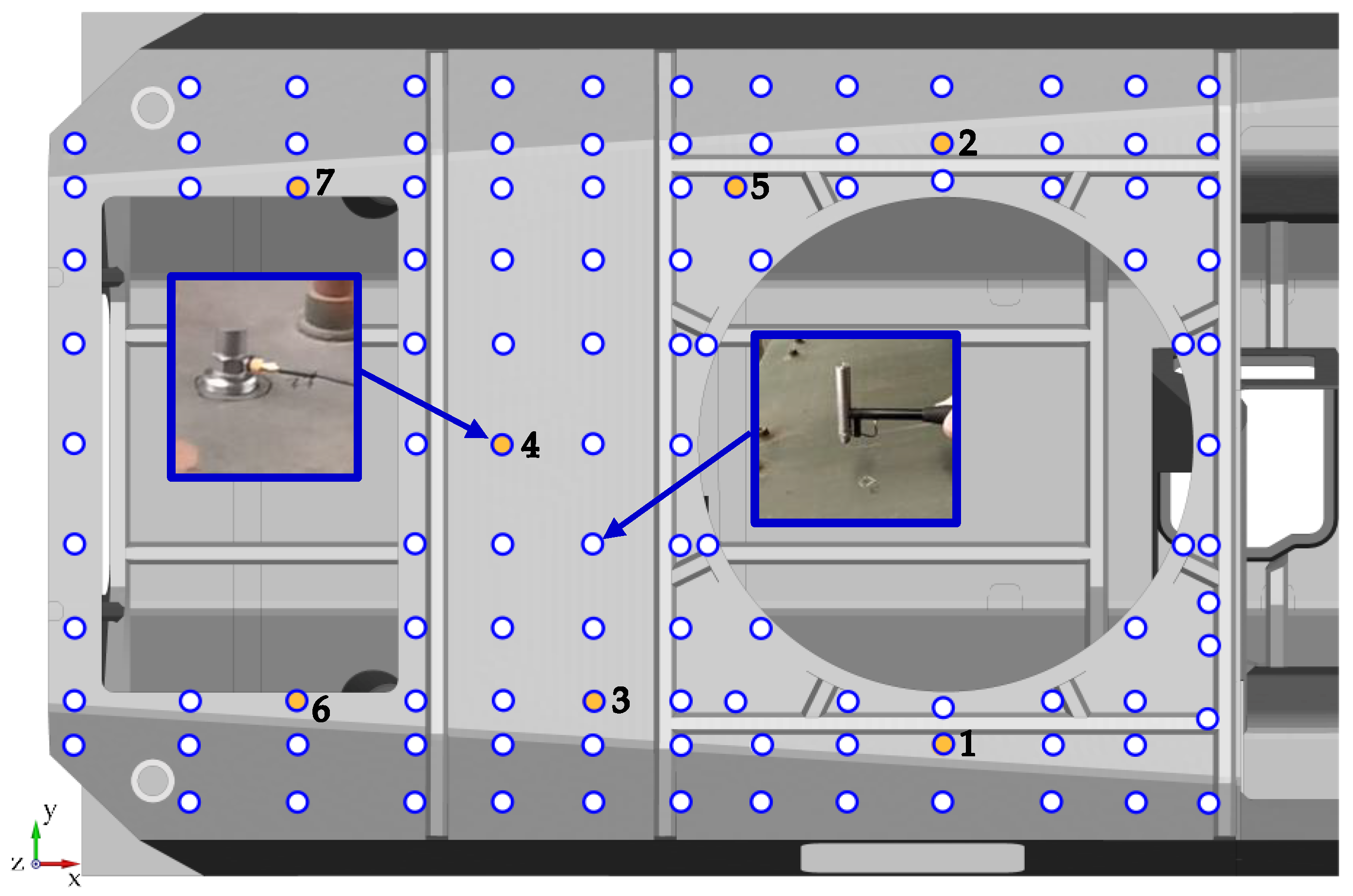

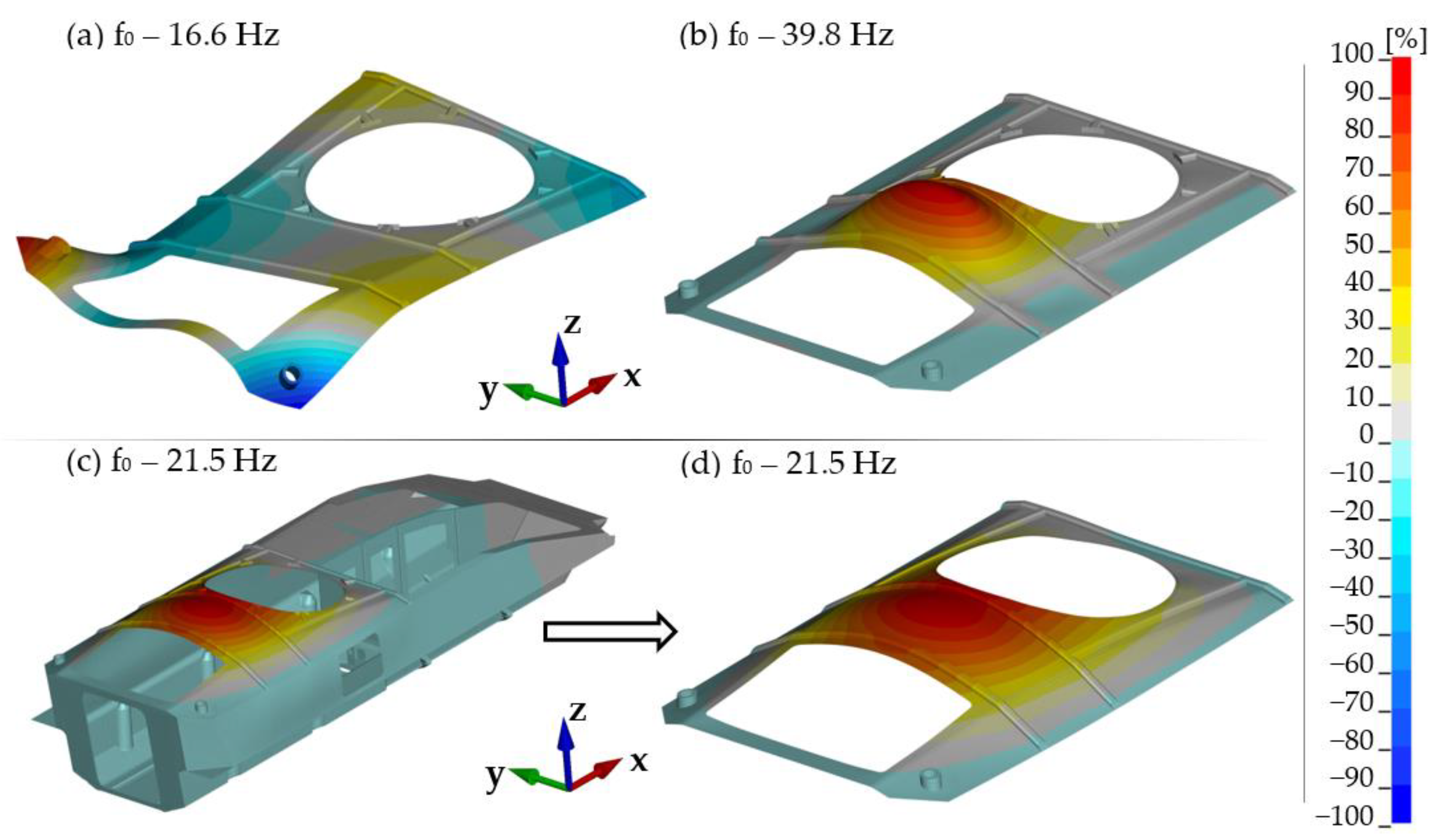
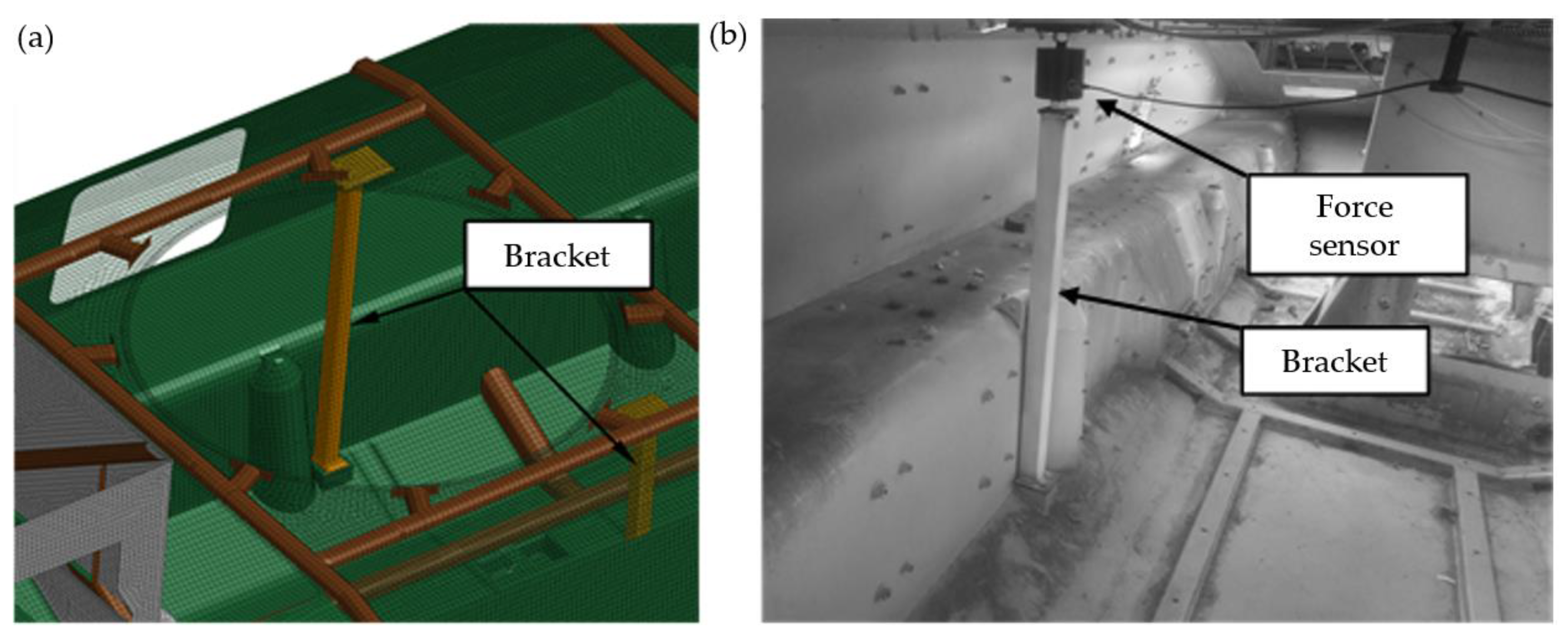


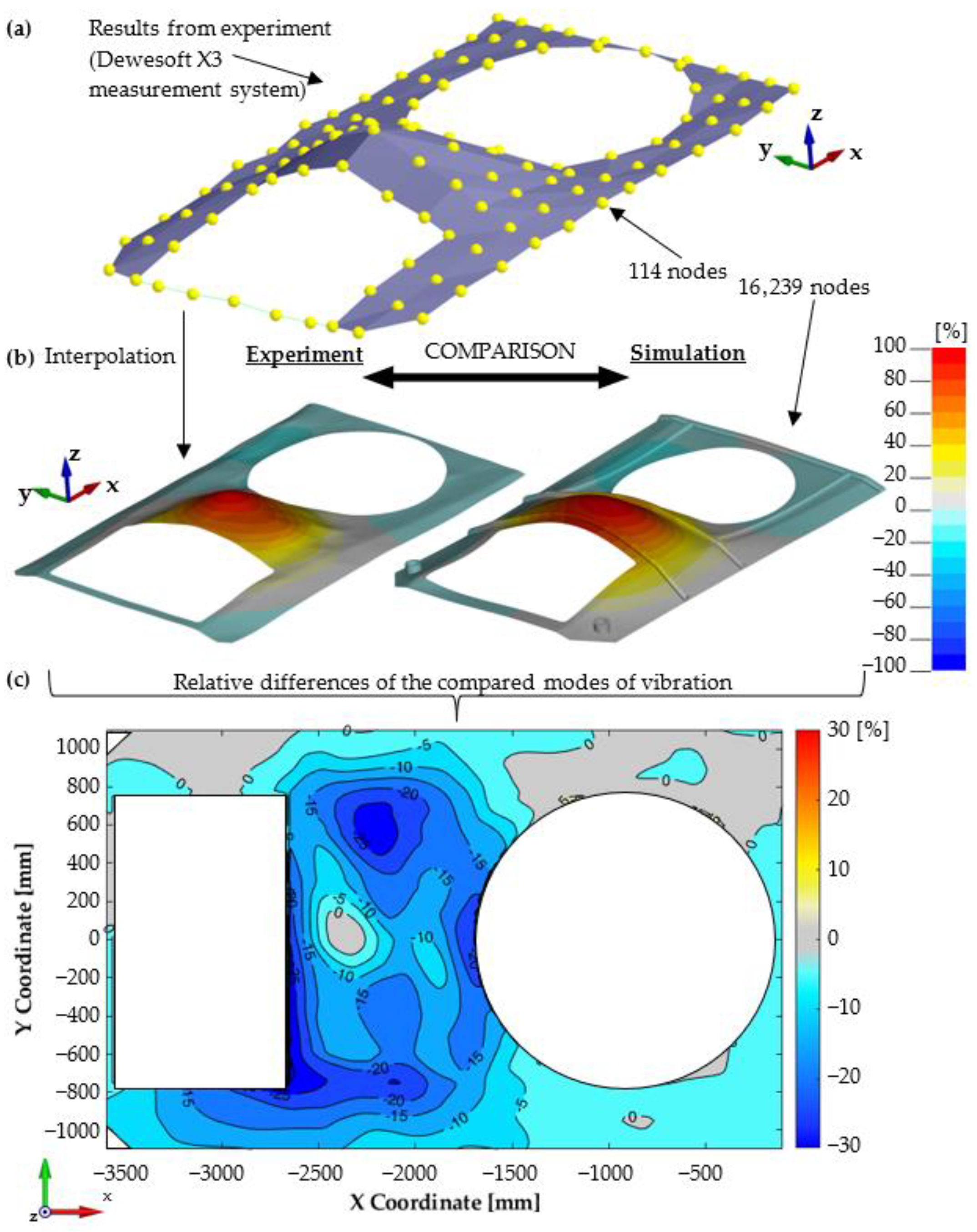
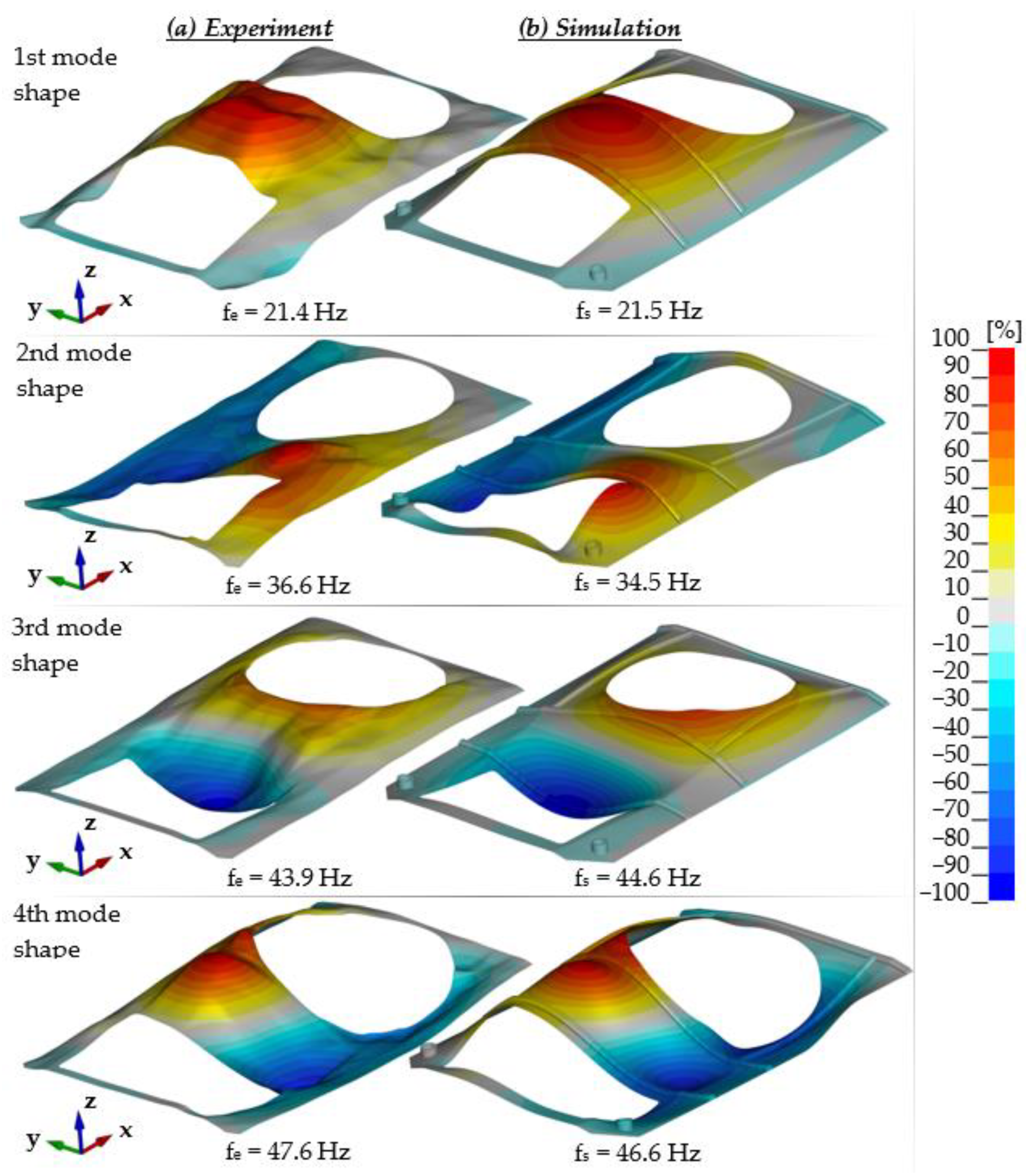

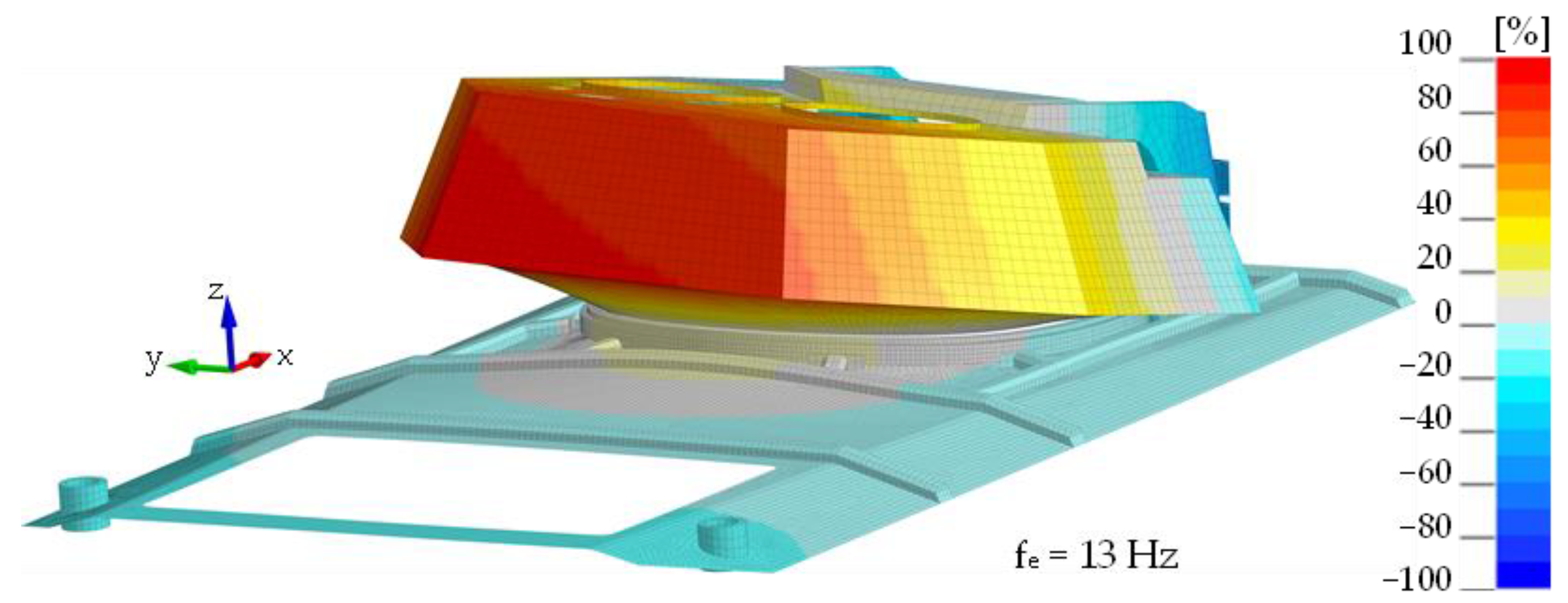




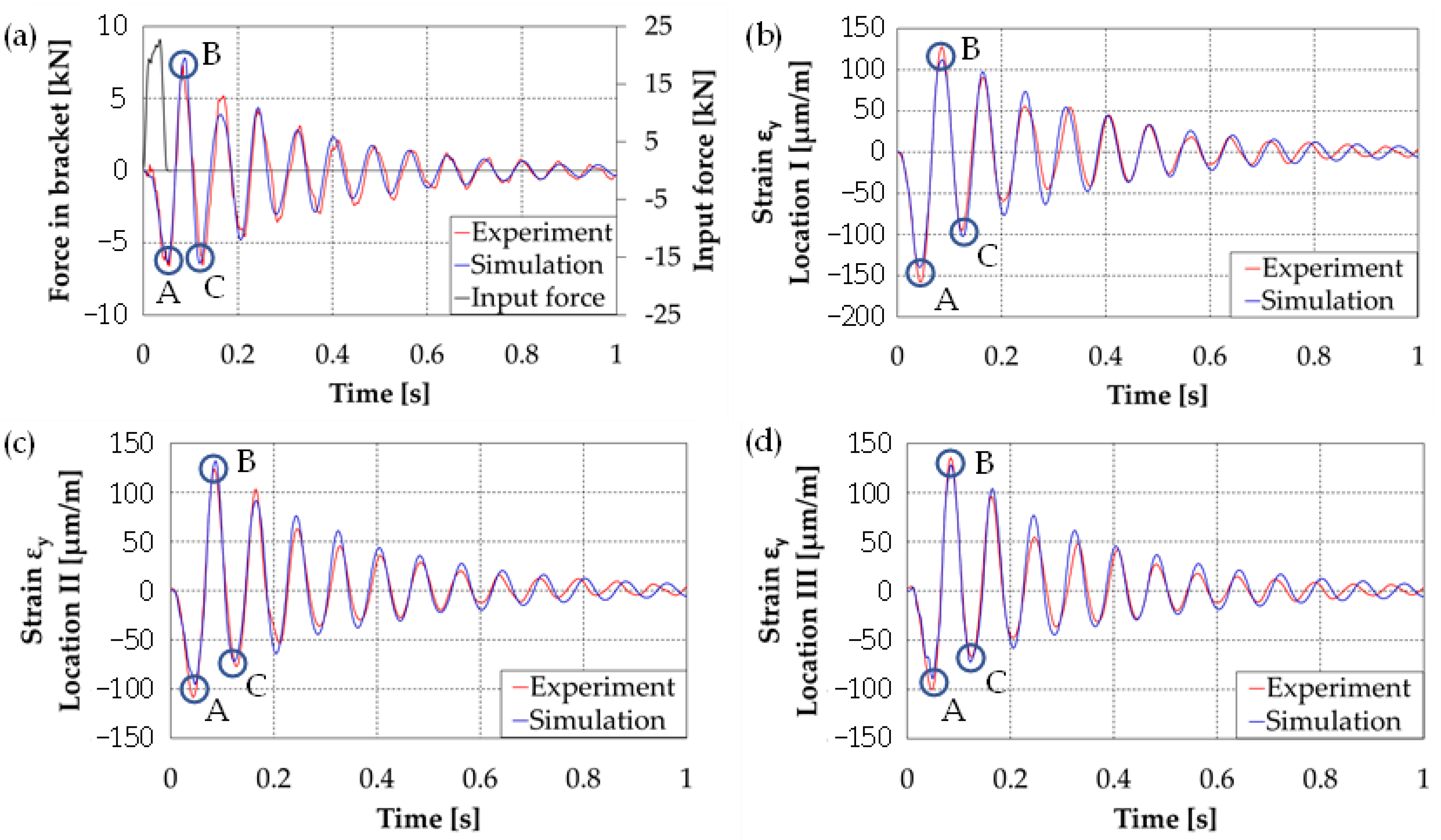
| Rp0.2 (MPa) | Rm (MPa) | A5 (%) | Hardness HBW | Elastic Modulus E (GPa) |
|---|---|---|---|---|
| 1250 (minimum) | 1450–1750 | 8 (minimum) | 480–540 | 207 |
| A [MPa] | B [MPa] | n | C | m |
| 849 | 1340 | 0.0923 | 0.00541 | 0.870 |
| Hull Configuration | Frequency (Hz) | Natural Frequency Difference (%) | MAC | |
|---|---|---|---|---|
| Experiment | Simulation | |||
| 1 | fe1 = 21.4 | fs1 = 21.5 | 0.47 | 0.960 |
| fe2 = 36.6 | fs2 = 34.5 | 6.1 | 0.960 | |
| fe3 = 43.9 | fs3 = 44.6 | 1.6 | 0.937 | |
| fe4 = 47.6 | fs4 = 46.6 | 2.1 | 0.924 | |
| 2 | fe1 = 30.5 | fs1 = 31.4 | 3.0 | 0.944 |
| fe2 = 46.4 | fs2 = 47.4 | 2.2 | 0.932 | |
| fe3 = 53.7 | fs3 = 51.9 | 3.5 | 0.985 | |
| 3 | fe1 = 31.1 | fs1 = 31.7 | 1.9 | 0.944 |
| fe2 = 46.1 | fs2 = 46.8 | 1.5 | 0.929 | |
| fe3 = 52.2 | fs3 = 49.7 | 5.0 | 0.939 | |
| 4 | fe1 = - | fs1 = 13.1 | - | - |
| fe2 = 30.8 | fs2 = 32.1 | 4.2 | 0.961 | |
| fe3 = 40.6 | fs3 = 40.6 | 0.0 | 0.906 | |
| fe4 = 56.8 | fs4 = 56.8 | 0.0 | 0.860 | |
| Indicator | Force | Strain εY | |||
|---|---|---|---|---|---|
| Location I | Location II | Location III | |||
| MAC | 0.889 | 0.902 | 0.885 | 0.892 | |
| R | 0.944 | 0.950 | 0.941 | 0.944 | |
| Relative error (%) | A | 3.95 | 11.6 | 12.0 | 11.6 |
| B | 4.98 | 12.9 | 7.67 | 6.19 | |
| C | 2.75 | 7.41 | 6.74 | 8.10 | |
Publisher’s Note: MDPI stays neutral with regard to jurisdictional claims in published maps and institutional affiliations. |
© 2021 by the authors. Licensee MDPI, Basel, Switzerland. This article is an open access article distributed under the terms and conditions of the Creative Commons Attribution (CC BY) license (https://creativecommons.org/licenses/by/4.0/).
Share and Cite
Hryciów, Z.; Małachowski, J.; Rybak, P.; Wiśniewski, A. Research of Vibrations of an Armoured Personnel Carrier Hull with FE Implementation. Materials 2021, 14, 6807. https://doi.org/10.3390/ma14226807
Hryciów Z, Małachowski J, Rybak P, Wiśniewski A. Research of Vibrations of an Armoured Personnel Carrier Hull with FE Implementation. Materials. 2021; 14(22):6807. https://doi.org/10.3390/ma14226807
Chicago/Turabian StyleHryciów, Zdzisław, Jerzy Małachowski, Piotr Rybak, and Andrzej Wiśniewski. 2021. "Research of Vibrations of an Armoured Personnel Carrier Hull with FE Implementation" Materials 14, no. 22: 6807. https://doi.org/10.3390/ma14226807
APA StyleHryciów, Z., Małachowski, J., Rybak, P., & Wiśniewski, A. (2021). Research of Vibrations of an Armoured Personnel Carrier Hull with FE Implementation. Materials, 14(22), 6807. https://doi.org/10.3390/ma14226807







